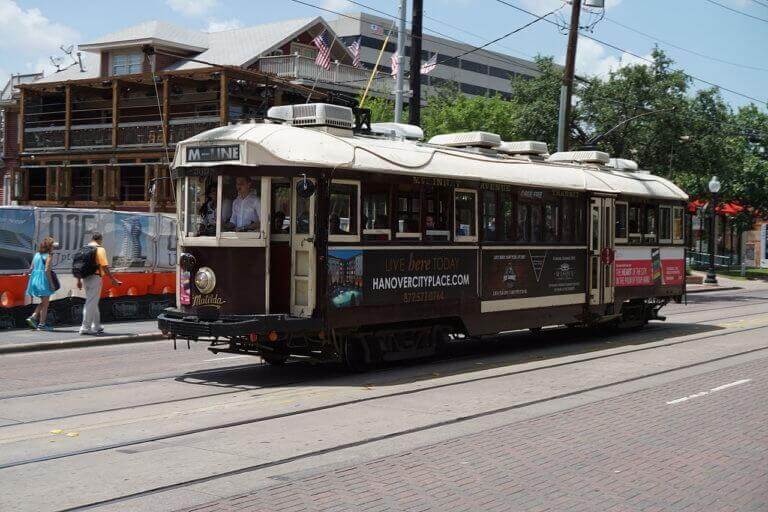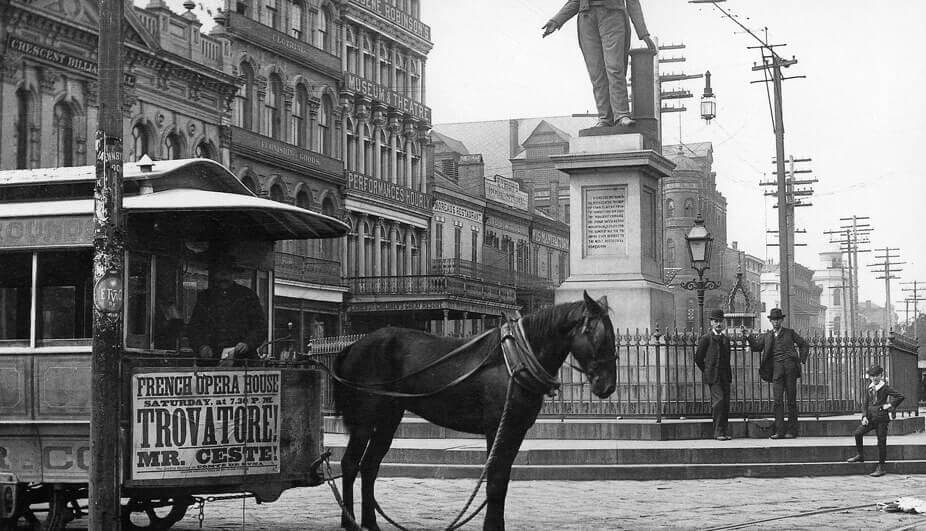
Transit advertising has been around for years. With a reach of over 30 million people per week, transit advertising is undoubtedly a significant part of out-of-home (OOH) advertising. According to the American Public Transit Association, advertising generates nearly half a billion dollars every year for the transit industry. Many have taken for granted the existence of transit advertising. However, the industry has not always been filled with colourful posters and digital screens. This article will investigate how transit advertising has evolved over the years.
Streetcar Advertising (1850’s)
The earliest recorded evidence of transit advertising in the US dates back to 1850. Found in New York City was the first panel sign fixed to the outside of streetcars to advertise the local department store, Lord & Taylor. Much like advertising operators now, streetcar conductors back then contracted for space often as a side gig and received concessions from streetcar companies. While Lord & Taylor was the earliest recorded company to practice card car advertising, a man named Chase was one of the earliest streetcar conductors to begin contracting space in streetcars.

The Rise of Transit Advertising (1875-1886)
William J. Carleton was another pioneer in the developing industry of transit advertising. As a conductor on the Third Avenue line in New York City, Carleton was one of the first to pursue advertising as a career, regularly tacking up signs in his car for his patrons while collecting fairs. This action was considered to be the first attempt to handle the sale of space in streetcars systematically. By 1886, Carleton retired from his life as a streetcar conductor and devoted all his attention towards streetcar advertising where he made contracts for inserting cards.
Around the same time, Mr. Rosenfield, seeing the potential in transit advertising, got the cooperation of Colonel George Bliss and the late Charles Jenkins, and organized the Manhattan Railway Advertising Company. The company started in 1883, and was able to sell over $2,000,000 worth of space in the span of fifteen years.
In addition to the people, were the cars. Larger cable-drawn cars, better adapted to advertising, gave immense propulsion to the transit advertising industry. These cars, originally developed in San Francisco in the 1870’s, had expanded to many larger cities by 1885. Unlike the old horsecars, the cable-drawn cars were better lighted, well furnished, and more spacious — creating a more attractive environment for advertisements.
As interest in the industry increased, new companies were formed, expanding from New York City to all of America. According to a study by James Hind, the revenue for street-car advertising was estimated at $25,000 for the United States in the year 1886 alone.
The New Standard (1889-1890)
In 1889, William J. Carleton and George Kissam formed the firm Carleton & Kissam. Before this, each operation was limited to local sales. Carleton & Kissam is recognized as the first to sell streetcar advertising on a national basis. It was also around this time that electric cars were invented. With better lighting and greater size, transit advertising bloomed once more. The new electric cars did much to encourage card car advertising, as these cars were constructed with a new standardized size of car cards. With the standardization of space, came the standardization of cards. In 1890, the Randall Card Rack was invented. This made for the possibility of more frequent changes in advertisement. The use of standardized cards increased revenue in the transit advertising industry, with a total growth to an estimated $200,000 in 1890. The standardizations resulted in further increases in national advertising, and by 1895, Carleton & Kissam had control of 9000 cars across 54 cities. The same year, the Street Railway Journal gave credit to Carleton & Kissam for pioneering the first systemization of streetcar advertising.
Modern Transit Advertising
Transit advertising has come a long way with the introduction of airplanes, the advancements in cars, and the overall modernization of transportation. New variations have been introduced since the early days of streetcar panels from taxi cabs to bus shelters. Today, we see entire vehicles wrapped with advertising, not a nook or cranny missed. For the right price, nearly every square inch of a vehicle can be covered in advertisement.
In 2019, Nielsen, a data and measurement firm, presented the findings of its 2019 Out of Home Advertising Study at the yearly OAAA show. Part of the study measured the reach of a variety of OOH advertising including many forms of transit advertising. Nielsen found that full wrapped vehicles garnered the attention of around 64% of U.S residents aged 16 or older. Public bus advertising caught the attention of 55% U.S residents in the same demographic.
Future Outlook of Transit Advertising
While it may seem that there is a shortage of real estate, the growth of transit advertising is not slowing down. Brands are now looking to explore what the digital world holds in store for transit advertising, with an increasing variety of digitized formats now in stations as well as vehicles inside and out. The history of transit advertising is not yet finished, and the development of this industry is expected to grow for the years to come.


